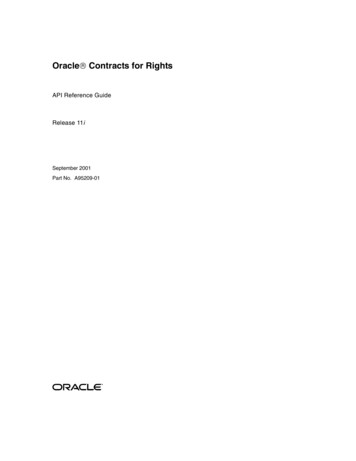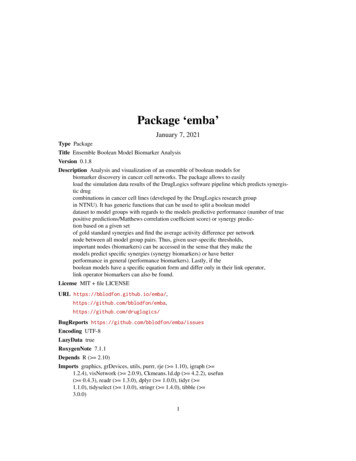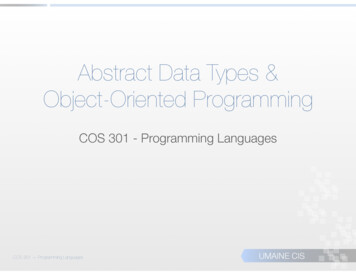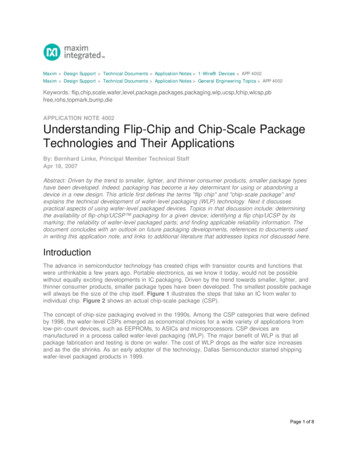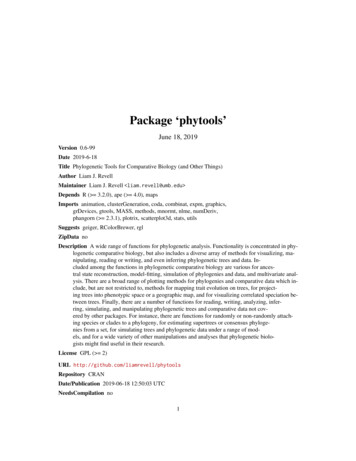
Transcription
Package ‘phytools’June 18, 2019Version 0.6-99Date 2019-6-18Title Phylogenetic Tools for Comparative Biology (and Other Things)Author Liam J. RevellMaintainer Liam J. Revell liam.revell@umb.edu Depends R ( 3.2.0), ape ( 4.0), mapsImports animation, clusterGeneration, coda, combinat, expm, graphics,grDevices, gtools, MASS, methods, mnormt, nlme, numDeriv,phangorn ( 2.3.1), plotrix, scatterplot3d, stats, utilsSuggests geiger, RColorBrewer, rglZipData noDescription A wide range of functions for phylogenetic analysis. Functionality is concentrated in phylogenetic comparative biology, but also includes a diverse array of methods for visualizing, manipulating, reading or writing, and even inferring phylogenetic trees and data. Included among the functions in phylogenetic comparative biology are various for ancestral state reconstruction, model-fitting, simulation of phylogenies and data, and multivariate analysis. There are a broad range of plotting methods for phylogenies and comparative data which include, but are not restricted to, methods for mapping trait evolution on trees, for projecting trees into phenotypic space or a geographic map, and for visualizing correlated speciation between trees. Finally, there are a number of functions for reading, writing, analyzing, inferring, simulating, and manipulating phylogenetic trees and comparative data not covered by other packages. For instance, there are functions for randomly or non-randomly attaching species or clades to a phylogeny, for estimating supertrees or consensus phylogenies from a set, for simulating trees and phylogenetic data under a range of models, and for a wide variety of other manipulations and analyses that phylogenetic biologists might find useful in their research.License GPL ( 2)URL http://github.com/liamrevell/phytoolsRepository CRANDate/Publication 2019-06-18 12:50:03 UTCNeedsCompilation no1
R topics documented:2R topics documented:phytools-package . . .add.arrow . . . . . . .add.color.bar . . . . .add.everywhere . . . .add.random . . . . . .add.simmap.legend . .add.species.to.genus . .aic.w . . . . . . . . . .allFurcTrees . . . . . .anc.Bayes . . . . . . .anc.ML . . . . . . . .anc.trend . . . . . . . .ancThresh . . . . . . .anoletree . . . . . . . .applyBranchLengths .as.multiPhylo . . . . .ave.rates . . . . . . . .averageTree . . . . . .bd . . . . . . . . . . .bind.tip . . . . . . . .bind.tree.simmap . . .bmPlot . . . . . . . . .branching.diffusion . .brownie.lite . . . . . .brownieREML . . . .cladelabels . . . . . . .collapse.to.star . . . .collapseTree . . . . . .compare.chronograms .consensus.edges . . . .contMap . . . . . . . .cophylo . . . . . . . .cospeciation . . . . . .countSimmap . . . . .ctt . . . . . . . . . . .density.multiSimmap .densityMap . . . . . .densityTree . . . . . .describe.simmap . . .di2multi.simmap . . .dotTree . . . . . . . .drop.clade . . . . . . .drop.leaves . . . . . .drop.tip.contMap . . .drop.tip.simmap . . . .Dtest . . . . . . . . . 2333434363839404142444546474949505152
R topics documented:edgeProbs . . . . .estDiversity . . . .evol.rate.mcmc . .evol.vcv . . . . . .evolvcv.lite . . . .exhaustiveMP . . .expand.clade . . .export.as.xml . . .fancyTree . . . . .fastAnc . . . . . .fastBM . . . . . .fastMRCA . . . . .findMRCA . . . .fit.bd . . . . . . . .fitBayes . . . . . .fitDiversityModel .fitMk . . . . . . .fitPagel . . . . . .force.ultrametric . .gammatest . . . . .genSeq . . . . . . .geo.legend . . . . .get.treepos . . . . .getCladesofSize . .getDescendants . .getExtant . . . . .getSisters . . . . .getStates . . . . . .labelnodes . . . . .ladderize.simmap .lambda.transform .likMlambda . . . .linklabels . . . . .locate.fossil . . . .locate.yeti . . . . .ls.tree . . . . . . .ltt . . . . . . . . .ltt95 . . . . . . . .make.era.map . . .make.simmap . . .map.overlap . . . .map.to.singleton . .mapped.states . . .markChanges . . .matchNodes . . . .mergeMappedStatesmidpoint.root . . .minRotate . . . . 04105
R topics documented:4minSplit . . . . . . . .modified.Grafen . . . .mrp.supertree . . . . .multi.mantel . . . . . .multiC . . . . . . . . .multiRF . . . . . . . .nodeHeights . . . . . .nodelabels.cophylo . .optim.phylo.ls . . . . .orderMappedEdge . . .paintSubTree . . . . .paste.tree . . . . . . .pbtree . . . . . . . . .pgls.Ives . . . . . . . .phenogram . . . . . .phyl.cca . . . . . . . .phyl.pairedttest . . . .phyl.pca . . . . . . . .phyl.resid . . . . . . .phyl.RMA . . . . . . .phyl.vcv . . . . . . . .phylANOVA . . . . . .phylo.heatmap . . . . .phylo.impute . . . . .phylo.to.map . . . . .phylo.toBackbone . . .phyloDesign . . . . . .phylomorphospace . .phylomorphospace3d .phylosig . . . . . . . .plot.backbonePhylo . .plotBranchbyTrait . . .plotSimmap . . . . . .plotThresh . . . . . . .plotTree . . . . . . . .plotTree.datamatrix . .plotTree.errorbars . . .plotTree.wBars . . . .posterior.evolrate . . .posthoc . . . . . . . .print.backbonePhylo .ratebystate . . . . . . .ratebytree . . . . . . .rateshift . . . . . . . .read.newick . . . . . .read.simmap . . . . . .reorder.backbonePhyloreorderSimmap . . . 146147148149150151152153154155157158159161161
phytools-packagerep.phylo . . . .reroot . . . . . .rerootingMethodrescaleSimmap .resolveNode . . .rotateNodes . . .roundBranches .roundPhylogramrstate . . . . . . .sampleFrom . . .setMap . . . . . .sim.corrs . . . . .sim.history . . .sim.ratebystate .sim.rates . . . . .skewers . . . . .splitEdgeColor .splitplotTree . . .splitTree . . . . .starTree . . . . .strahlerNumber .threshBayes . . .threshDIC . . . .threshState . . . .to.matrix . . . . .treeSlice . . . . .untangle . . . . .vcvPhylo . . . .write.simmap . .writeAncestors .writeNexus . . 187188189190191192193phytools: Phylogenetic Tools for comparative biology (and otherthings)Descriptionphytools provides functions for phylogenetic comparative biology; as well as several other functions for tree inference, manipulation, and analysis that are not implemented in other R packages.The complete list of functions can be displayed with library(help phytools).More information on phytools can be found at http://www.phytools.org or http://blog.phytools.org.
6add.arrowAuthor(s)Liam J. RevellMaintainer: Liam J. Revell liam.revell@umb.edu ReferencesRevell, L. J. (2012) phytools: An R package for phylogenetic comparative biology (and otherthings). Methods Ecol. Evol., 3, 217-223.add.arrowAdd an arrow pointing to a tip or node on the treeDescriptionThis function adds an arrow to a plotted tree.Usageadd.arrow(tree NULL, tip, .)Argumentstreean object of class "phylo", "contMap", or "densityMap". If not supplied, thefunction will obtain the last plotted phylogeny from the environmental variablelast plot.phylo.tiplabel of tip or tip or node number. If tree NULL then the tip or node numbermust be supplied.optional arguments to control the shape and size of the arrow including: itslength (arrl) in the units of the plot; the length of the arrowhead (hedl); thetotal angle between the wings in the arrowhead (angle); the line width for theplotted lines (lwd); the offset from the tip or end of tip label, in character widths(offset); and the color (col).DetailsThis function presently works for radial (type "fan") and right facing square phylograms (type "phylogram"). Trees can be plotted using phytools function plotTree, plotSimmap, contMap,densityMap, and ape S3 method plot.phylo.Author(s)Liam Revell liam.revell@umb.edu ReferencesRevell, L. J. (2012) phytools: An R package for phylogenetic comparative biology (and otherthings). Methods Ecol. Evol., 3, 217-223.
add.color.bar7See Alsonodelabelsadd.color.barAdd color bar to a plotDescriptionThis function adds a color bar to a plot created by plotBranchbyTrait. A color bar can be addedby clicking on a location within the plot (when prompt TRUE) or by setting prompt FALSE andsupplying x & y coordinates for the object. This function is also used internally by S3 methodsplot.contMap and plot.densityMap, as well as by errorbar.contMap.Usageadd.color.bar(leg, cols, title NULL, lims c(0,1), digits 1, prompt TRUE,lwd 4, outline TRUE, numerical value for the length of the legend.colors for the legend.text to plot above the bar.range for the bar.digits for plotted numbers.logical value indicating whether the location of the legend should be obtainedinteractively.width of the plotted bar.logical value indicated whether or not to outline the plotted color bar with a 1 ptline.optional arguments including: x x-coordinate of the legend (if prompt FALSE);y y-coordinate of the legend; subtitle optional legend subtitle; directiondirection of the color bar (i.e., increase from left to right or from right to left);and fsize, font size for the legend text.Author(s)Liam Revell liam.revell@umb.edu ReferencesRevell, L. J. (2013) Two new graphical methods for mapping trait evolution on phylogenies. Methods in Ecology and Evolution, 4, 754-759.See AlsocontMap, densityMap, errorbar.contMap, plotBranchbyTrait
8add.randomadd.everywhereAdd tip to all edges in a treeDescriptionThis function adds a tip to all branches of the tree and returns a a list of trees as an object of class"multiPhylo".Usageadd.everywhere(tree, tip.name)Argumentstreean object of class "phylo".tip.namea string containing the name of the tip to add.ValueA list of trees as an object of class "multiPhylo". Since the tip can be added to any branch, thelength of the list is equal to the number of edges in tree.Author(s)Liam Revell liam.revell@umb.edu ReferencesRevell, L. J. (2012) phytools: An R package for phylogenetic comparative biology (and otherthings). Methods Ecol. Evol., 3, 217-223.See AlsoallFurcTrees, exhaustiveMPadd.randomAdd tips at random to the treeDescriptionThis function adds new tips at random to a tree with branch lengths. If no edge lengths are provided, and the tree is ultrametric, then edge lengths are assigned to keep the tree ultrametric. Theprobability that at new tip is added along any branch is directly proportional to the length of thebranch.
add.simmap.legend9Usageadd.random(tree, n NULL, tips NULL, edge.length NULL, order c("random","input"))Argumentstreean object of class "phylo".na number of tips to add to the tree. If NULL, will use length(tips).tipsa set of tip names for the added tips. If NULL, names will be suppliededge.lengthterminal edge length for the added tips. If NULL, and is.ultrametric(tree) TRUE, then edge lengths will be assigned to keep the tree ultrametric. Note thatif edge lengths are assigned and n 1, then the asssigned terminal edge lengthsare not guaranteed as subsequent random tip addition could occur along the newterminal edge.orderaddition order for the new tips.DetailsNote that sometimes the resultant tree plotted with plot.phylo or plotSimmap may display withbranches crossing. If so, the tree can be ’untangled’ using untangle.ValueAn object of class "phylo".Author(s)Liam Revell liam.revell@umb.edu ReferencesRevell, L. J. (2012) phytools: An R package for phylogenetic comparative biology (and otherthings). Methods Ecol. Evol., 3, 217-223.See AlsoallFurcTrees, add.everywhereadd.simmap.legendAdd legend to stochastically mapped treeDescriptionThis function adds a legend (by default, interactively) to a plotted stochastic character mapped tree.Usageadd.simmap.legend(leg NULL, colors, prompt TRUE, vertical TRUE, .)
10add.species.to.genusArgumentslegstates for the discrete character in the order of colors.colorscolors for the legend in the order of leg, or, if leg NULL, named vector of colorsin which names(colors are the states of the mapped discrete character.promptlogical value indicating whether the location of the legend should be obtainedinteractively (i.e., by clicking in the plotting area).verticallogical value indiciating whether to plot the legend vertically (if TRUE) or horizontally.optional arguments including: x x-coordinate of the legend (if prompt FALSE);y y-coordinate of the legend; and shape which can be shape "square", thedefault, or shape "circle".Author(s)Liam Revell liam.revell@umb.edu ReferencesRevell, L. J. (2012) phytools: An R package for phylogenetic comparative biology (and otherthings). Methods Ecol. Evol., 3, 217-223.See AlsoplotSimmapadd.species.to.genusAdd species to genus on a phylogeny or bind simulated species subtrees to a backbone genus treeDescriptionadd.species.to.genus adds an additional species to a genus on a phylogeny.genus.to.species.tree simulates pure-birth subtrees and then binds them at a random heightalong the terminal edge leading to each corresponding genus on a genus-level backbone tree.Usageadd.species.to.genus(tree, species, genus NULL, where c("root","random"))genus.to.species.tree(tree, species)
add.species.to.genus11Argumentstreean object of class "phylo". In the case of genus.to.species.tree this shouldbe a genus-level backbone tree.speciesstring contain species name in the format "Genus species" or "Genus species".genusfor add.species.to.genus, optional argument containing the genus to whichspecies is to be attached. If NULL then genus will be extracted from species.wherefor add.species.to.genus, the location to attach species to the tree. where "root" will cause the species to be attached to the MRCA of all members ofgenus. where "random" will cause species to be attached at random to thesubtree descended from the MRCA of all members of genus.DetailsFor add.species.to.genus, if genus contains only one species and where "root", then specieswill be attached midway along the branch leading to the one species. If where "random" thenspecies will be added at a random position along the edge. If genus cannot be found in the tree,then the original tree is returned and a warning printed. If the tree is not ultrametric, then theresultant tree may not contain branch lengths and a warning will be printed. Note that for somecases in which a tree is read in from file, R may initially think it is ultrametric, but then later (astips are added) decide that it is not due to rounding of the edge lengths when it was written to file.This can most likely be resolved by using force.ultrametric to coerce the tree to be exactlyultrametric (to the maximum numerical precision permitted by R) before adding tips to the tree. Ifgenus is non-monophyletic then species will be attached to the most inclusive group containingmembers of genus and a warning will be printed.ValueAn object of class "phylo".Author(s)Liam Revell liam.revell@umb.edu ReferencesRevell, L. J. (2012) phytools: An R package for phylogenetic comparative biology (and otherthings). Methods Ecol. Evol., 3, 217-223.See Alsoadd.random, bind.tip
12allFurcTreesaic.wComputes AIC weightsDescriptionThis function computes AIC weights for a set of fitted models. It returns an object of class "aic.w"which is just a vector which allows it to be automatically printed with a numerical precision of 8significant digits.Usageaic.w(aic)Argumentsaicvector of AIC values for different fitted models. If the vector has names, thesenames will be inherited by the vector returned by the function.ValueA vector of AIC weights.Author(s)Liam Revell liam.revell@umb.edu ReferencesRevell, L. J. (2012) phytools: An R package for phylogenetic comparative biology (and otherthings). Methods Ecol. Evol., 3, 217-223.allFurcTreesGenerate all bi- and multifurcating unrooted treesDescriptionThis function creates all possible unrooted bi- and multifurcating trees and returns a list of trees asan object of class "multiPhylo".UsageallFurcTrees(n, tip.label NULL, to.plot TRUE)
anc.Bayes13Argumentsnan integer giving the desired number of species.tip.labelan optional vector of length n containing the tip names.to.plotan optional logical value indicating whether or not to plot the trees.DetailsThis function should be used with caution for n greater than about 8, as in this case the number ofpossible trees is extremely large.ValueA list of trees as an object of class "multiPhylo".Author(s)Liam Revell liam.revell@umb.edu ReferencesFelsenstein, J. 2004. Inferring Phylogenies. Sinauer.Revell, L. J. (2012) phytools: An R package for phylogenetic comparative biology (and otherthings). Methods Ecol. Evol., 3, 217-223.See Alsoadd.everywhere, exhaustiveMPanc.BayesBayesian ancestral character estimationDescriptionThis function uses Bayesian MCMC to sample from the posterior distribution for the states at internal nodes in the tree.Usageanc.Bayes(tree, x, ngen 10000, control list())
14anc.BayesArgumentstreean object of class "phylo".xa vector of tip values for species; names(x) should be the species names.ngena integer indicating the number of generations for the MCMC.controla list of control parameters containing the following elements: sig2: startingvalue for σ 2 (BM rate); a: starting for the state at the root node; y: startingvalues for the states at all internal nodes excluding the root (should be labeledwith node numbers); pr.mean: means for the prior distributions in the followingorder - sig2, a, y, note that the prior probability distribution is exponential forsig2 and normal for a and y; pr.var: variances on the prior distributions, sameorder as pr.mean (but the variance is not used for sig2); prop: variances on thenormal proposal distributions in the same order as pr.mean; sample: samplefrequency from the MCMC.DetailsThe print method also returns (invisibly) a vector of estimated ancestral states based on a usersupplied burn-in (or 20The object class plot method by default plots a likelihood profile from the MCMC.ValueAn object of class "anc.Bayes" including at least two components:mcmca data frame with rows ngen/sample 1 containing the posterior sample andlikelihoods. Matrix columns are labeled either sig2 or by the node number ofthe internal node.treeour input phylogeny.Author(s)Liam Revell liam.revell@umb.edu ReferencesRevell, L. J. (2012) phytools: An R package for phylogenetic comparative biology (and otherthings). Methods Ecol. Evol., 3, 217-223.See Alsoace, anc.ML, anc.trend, evol.rate.mcmc, fastAncExamplestree -pbtree(n 50)x -fastBM(tree,sig2 2) # simulate using fastBMobj -anc.Bayes(tree,x,ngen 10000) # sample ancestral statesprint(obj,printlen 20) ## estimates
anc.MLanc.ML15Ancestral character estimation using likelihoodDescriptionThis function estimates the evolutionary parameters and ancestral states for Brownian evolutionusing likelihood. It is also possible (for model "BM") to allow for missing data for some tip taxa.Usageanc.ML(tree, x, maxit 2000, model c("BM","OU","EB"), .)Argumentstreean object of class "phylo".xa vector of tip values for species; names(x) should be the species names.maxitan optional integer value indicating the maximum number of iterations for optimization.modelmodel of continuous character evolution ont he tree. It’s possible that onlymodel "BM" & model "EB" work in the present version as model "OU" has notbe thoroughly tested & some bugs were reported for an earlier version.other arguments.DetailsBecause this function relies on a high dimensional numerical optimization of the likelihood function, fastAnc should probably be preferred for most purposes. If using anc.ML, users should becautious to ensure convergence. This has been ameliorated in phytools 0.2-48 by seeding the MLoptimization with the result from fastAnc. For model "EB" this should also not be a problem asthe numerical optimization is performed for only sig2 and r, while the ML values of the ancestralstates are obtained during every iteration of the optimization algorithmically using the re-rootingmethod.ValueAn object of class "anc.ML" with at least the following four elements (if not more, depending onmodel):sig2the variance of the BM process.acea vector with the ancestral states.logLikthe log-likelihood.convergencethe value of convergence returned by optim() (0 is good).Author(s)Liam Revell liam.revell@umb.edu
16anc.trendReferencesRevell, L. J. (2012) phytools: An R package for phylogenetic comparative biology (and otherthings). Methods Ecol. Evol., 3, 217-223.Schluter, D., Price, T., Mooers, A. O., and Ludwig, D. (1997) Likelihood of ancestor states inadaptive radiation. Evolution 51, 1699-1711.See Alsoace, anc.Bayes, fastAnc, optimExamplestree -pbtree(n 50)x -fastBM(tree) # simulate using fastBManc.ML(tree,x) # fit model & estimate ancestral statesanc.trendAncestral character estimation with a trendDescriptionThis function estimates the evolutionary parameters and ancestral states for Brownian evolutionwith directional trend.Usageanc.trend(tree, x, maxit 2000)Argumentstreean object of class "phylo".xa vector of tip values for species; names(x) should be the species names.maxitan optional integer value indicating the maximum number of iterations for optimization.DetailsNote that this will generally only work and produce sensible results for a phylogeny with some noncontemporary tips (i.e., a tree with some fossil species). The function uses optim with method "L-BFGS-B"; however optimization is only constrained for the sig2 which must be 0.
ancThresh17ValueAn object of class "anc.trend" with the following components:acea vector with the ancestral states.mua trend parameter per unit time.sig2the variance of the BM process.logLthe log-likelihood.convergencethe value of convergence returned by optim() (0 is good).Author(s)Liam Revell liam.revell@umb.edu ReferencesRevell, L. J. (2012) phytools: An R package for phylogenetic comparative biology (and otherthings). Methods Ecol. Evol., 3, 217-223.See Alsoace, anc.Bayes, anc.ML, optimExamplestree -rtree(20)x -fastBM(tree,mu 2) # simulate using fastBM with a trend (m! 0)anc.trend(tree,x) # fit model & estimate ancestral statesancThreshAncestral character estimation under the threshold model usingBayesian MCMCDescriptionThis function uses Bayesian MCMC to estimate ancestral states and thresholds for a discrete character under the threshold model from quantitative genetics (Felsenstein 2012).UsageancThresh(tree, x, ngen 10000, sequence NULL, method "mcmc",model c("BM","OU","lambda"), control list(), .)
18ancThreshArgumentstreephylogenetic tree.xa named vector containing discrete character states; or a matrix containing thetip species, in rows, and probabilities of being in each state, in columns.ngennumber of generations to run the MCMC.sequenceassumed ordering of the discrete character state. If not supplied and x is a vectorthen numerical/alphabetical order is assumed; if not supplied and x is a matrix,then the column order of x is used.methodonly method currently available is "mcmc".modelmodel for the evolution of the liability. Options are "BM" (Brownian motion, thedefault), "OU" (Ornstein-Uhlenbeck), or "lambda" (the lambda model).controllist containing the following elements: sample, the sampling interval; propliabvariance of the proposal distribution for liabilities; propthresh variance on theproposal distribution for the thresholds; propalpha variance on the proposaldistribution for alpha (for model "OU"); pr.anc prior probability distributionon the ancestral states for each node, in a matrix - not all nodes need to besupplied; pr.th prior density on the thresholds; burnin number of generationsto exclude for burn-in when plotting posterior probabilities on the tree; plotlogical value i
logenetic comparative biology, but also includes a diverse array of methods for visualizing, ma-nipulating, reading or writing, and even inferring phylogenetic trees and data. In-cluded among the functions in phylogenetic comparative biology are various for ances-
